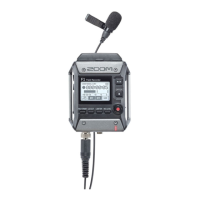
Do you have a question about the Zoom F1 and is the answer not in the manual?
| Type | Field Recorder |
|---|---|
| Audio Formats | WAV, MP3 |
| Max Sample Rate/Resolution | 96 kHz / 24-Bit |
| Power | 2 x AAA Batteries, USB Bus Power |
| Battery Life | Up to 10 hours |
| Simultaneous Recording Tracks | 2 |
| Built-In Microphone | No |
| Input Channels | 2 |
| Output Channels | 1 |
| USB | 1 x Micro-USB |
| Recording Media | microSD/microSDHC cards (up to 32 GB) |
| Dimensions | 64 x 79.8 x 34 mm |
| Display | Monochrome LCD |
| Line Input | 1 x 1/8" (3.5 mm) TRS |
| Headphone Output | 1 x 1/8" / 3.5 mm TRS |
| Microphone Input | 1 x 1/8" (3.5 mm) TRS |
Covers symbol meanings, operation, handling, environmental, and volume safety instructions.
Addresses interference, cleaning, breakdown, copyright, and FCC regulations.
Highlights the F1's compact design, mic capsule compatibility, format support, and advanced functions.
Identifies buttons, display, and connectors on the front of the F1 recorder.
Details the volume controls, USB port, card slot, power switch, and audio jacks.
Explains the file name, status icon, level meter, function buttons, battery, counter, and clipping indicator.
Describes the file name, status icon, progress bar, level meter, and playback controls.
Instructions for powering the device using AAA batteries.
Connecting the F1 to a power outlet using the AD-17 AC adapter.
Guide to inserting and removing microSD cards for storage.
Steps for powering the device on and off using the HOLD switch.
How to select the display language for the unit's interface.
Procedure for adding additional display languages to the unit via microSD card.
Instructions for setting the device's date and time for file management.
How to change the date display format (e.g., YYYY, MM, DD).
Using the HOLD function to prevent accidental button presses during operation.
Instructions for mounting the F1 onto a digital SLR camera using the shock mount.
Details on connecting ZOOM mic capsules and lavalier microphones.
Illustrates common usage scenarios for connecting microphones and cameras.
Enabling plug-in power for microphones connected to the F1.
How to adjust the side mic level (stereo width) for mid-side capsules.
Using test tones to calibrate audio levels with connected devices like cameras.
Guidance on setting optimal input signal levels for clear recordings.
How to monitor the recorded sound using headphones connected to the F1.
Using the Lo Cut filter to minimize low-frequency noise like wind and pops.
Configuring the limiter to prevent distortion from high input signal levels.
Choosing between WAV and MP3 formats based on quality and file size needs.
Steps for starting, pausing, resuming, and stopping audio recording.
Capturing audio up to 2 seconds before pressing the record button.
Instructions for playing back recorded audio files and performing basic operations.
Configuring playback modes: Play All, Repeat One, or Repeat All.
Removing unwanted cue marks from recorded files.
Viewing details such as date, time, format, and size of recorded files.
Removing unwanted audio files from the microSD card.
How to connect the F1 to computers or iOS devices via USB.
Utilizing the F1 as a microSD card reader to transfer files to a computer.
Connecting the F1 to devices as an audio interface for input/output.
Setting up direct monitoring for latency-free audio playback.
Customizing the naming convention for automatically saved recording files.
Selecting mono or stereo recording for files when using the MIC/LINE IN jack.
Activating the 'Rec Hold' function to prevent accidental button presses during recording.
Outputting tone signals for synchronizing audio and video when recording starts/stops.
Choosing to display elapsed time or remaining recording time on the counter.
Configuring how marks are added when pause or playback keys are used.
Adjusting the display backlight timeout duration for power saving.
Modifying the contrast level for better display readability.
Selecting the battery type for accurate remaining charge display.
Configuring the automatic power-off timer for unused periods.
Reformatting microSD cards for optimal compatibility and performance with the F1.
Checking microSD card compatibility using Quick or Full Test.
Viewing the current system and boot firmware versions of the F1.
Resetting all F1 settings to their original factory defaults.
Procedure for updating the F1's firmware to the latest version.
Solutions for common problems related to audio recording and playback.
Resolving issues like computer recognition, short battery life, and USB connectivity.
Detailed technical data for the F1 recorder, including media, formats, inputs, and power.